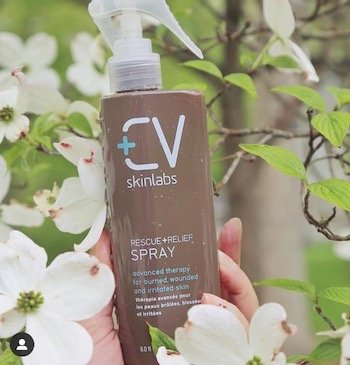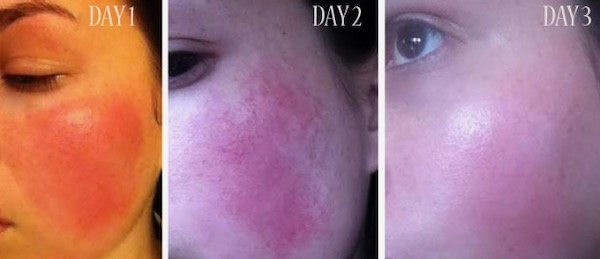
If you’re unlucky enough to suffer from skin redness, you know that it’s no small thing.
Results from a 2014 survey showed that people with rosacea (a skin condition that causes redness) were more likely to be judged negatively upon first impression compared to those with clear skin.
A similar survey of over 8,300 people showed that 84 percent of people with moderate-to-severe psoriasis suffered from discrimination and humiliation, with many being stared at in public.
Another survey from Braun found that dry, sensitive, or red skin was a major cause of anxiety among men, often reducing their quality of life.
Here at CV Skinlabs, we hate to see anyone struggling because of red skin. In this post, we share with you 10 reasons you may be suffering from skin redness, and how you can fix it.
What Causes Skin Redness?
Part of the reason it can be difficult to treat skin redness is that there are so many factors that may contribute to it. Here are some of the most common ones.
1. Can Anxiety Cause Red, Blotchy Skin?
Extreme emotions can indeed trigger redness in the face. If you become embarrassed or anxious, the face and neck may appear red and blotchy, or if you are angry or stressed out, you may suffer from skin flushing that moves from the neck up through the face.
This occurs because when you’re stressed, your body temperature rises, which can trigger the release of histamines. These are the same chemicals released when you suffer from an allergic reaction, and they can cause redness, hives, and red rashes on various areas of the body.
2. Skin Redness After Surgery
Skin redness can be a sign of healing in some cases. After surgery, for example, a small amount of redness indicates inflammation around the wound or incision. That means the immune system is working to protect and heal that area. The discoloration is normal and should start to fade with time. How much time will depend on the severity of the procedure.
3. Does Dry Skin Cause Red Spots?
Dry skin can lead to skin redness, particularly if the dry skin is severe and/or left untreated. Excessive dry skin can trigger eczema in those who are vulnerable to the condition, causing redness, cracking, and inflammation.
Severely dry skin can also cause redness even in those who don’t have eczema. That’s because dry skin is damaged skin, and the immune system tries to heal that damage, which causes inflammation and redness. Dry skin can also result in scaly, itchy red patches of damaged skin.
4. Many Skin Diseases Cause Skin Redness
Skin diseases like eczema, rosacea, and psoriasis all cause skin redness.
- Rosacea begins with flushing, then over time progresses to cause long-term redness of the skin, typically on the face.
- Psoriasis is a long-term condition that causes the overproduction of new skin cells, resulting in red, dry, crusty patches of skin.
- Eczema is the name for a group of skin conditions that cause the skin to become itchy, inflamed, and red.
- Seborrheic dermatitis causes a red rash, most commonly on the face. It can also make the skin look dry and scaly.
These diseases can’t be cured, unfortunately, but they can be treated with medications and careful skincare.
 5. Allergic Reactions Can Cause Skin Redness
5. Allergic Reactions Can Cause Skin Redness
If you are allergic to something and you touch it, your skin can react by becoming red, swollen, and inflamed.
Common irritants include soaps, dyes, poison ivy, fragrances, and latex.
Drug allergies can also cause skin rashes, hives, itching, and swelling.
In general, anything that you may be allergic to has the potential to cause skin redness.
6. Some Diseases Make the Skin Turn Red
Medical diseases like lupus and shingles can both cause red skin. Lupus is an autoimmune disease that can cause redness and swelling, and shingles is caused by the chickenpox virus and causes red, painful, blistering rashes.
Some types of cancer and cancer treatments like radiation and chemotherapy can also make the skin thin, sensitive, red, and inflamed. Scarlet fever may be the most well-known disease associated with red skin. Caused by Streptococcus bacteria, it creates a distinctive red rash on the neck and chest.
7. Skin Redness is a Symptom of Skin Infections
Anytime the skin suffers from an infection, it is likely to turn red as the immune system tries to eradicate that infection. Common examples include ringworm, athlete’s foot, scabies, and cellulitis (bacterial skin infection). A simple cut or scrape can also lead to an infection that causes redness.
8. Red Skin May Be Burned!
Skin that has been burned will turn red, and may also hurt, itch, and blister. The most common type of burn is sunburn, but radiation burns, chemical burns, and friction burns are also frequent sources of skin redness.
9. Your Red Skin Could be a Heat Rash
If you were outside in the summer sun exercising and you suffered a red rash, it may have been a heat rash. These can occur when you get hot and sweaty and your blocked pores trap perspiration under your skin. These rashes occur most commonly in skin folds where clothing causes friction.
10. Skin Redness Can Be a Sign of Sensitive Skin
If you have sensitive skin, you may experience frequent redness because your skin overreacts to a variety of triggers. Dry skin may turn red. If you apply a new skincare product with an ingredient your skin doesn’t like, it may turn red. Walk into a really warm room and your skin may turn red.
These reactions vary from person to person, but if your skin is often red and you’re not suffering from any of the other conditions mentioned in this list, it could be that you have hypersensitive skin.
What Can Be Done to Reduce Skin Redness and Renew Skin?
Whatever is causing your red skin, your main concern is fixing it. What can you do?
Keep in mind that if you have a skin condition like rosacea, psoriasis, or lupus, you can’t cure these conditions. Talk to your dermatologist, as he or she may have medications that will help.
If you are suffering from a skin infection, burn, or heat rash, these will likely clear up in time, though you can usually speed up your recovery by treating them carefully. For more serious cases, check with your doctor for the appropriate treatment.
Overall, the best approach is to adopt a regular skincare routine that will promote healthy skin that is better able to resist redness.
Your Skincare Routine for Dry, Red Skin
1. Cool Off
In many cases, skin redness occurs because of heat. If you have rosacea, flushing, a heat rash, or sensitive skin, you can tame the redness by simply cooling down. Reach for a cool drink, apply a cold compress to the red area, or suck on some ice. If you’re in the sun, move to the shade.
Another good option: spritz on some of our Rescue + Relief Spray. It has natural ingredients like cucumber and water lily that naturally remove heat from the skin without drying it. If you regularly struggle with red skin, take our travel size with you so you can use it whenever you need it.
2. Protect Your Skin at All Times
Though everyone benefits from protecting their skin from the sun, harsh weather, and pollution, those who suffer from skin redness need to be even more vigilant about it. Sun exposure can trigger redness in a heartbeat in those with sensitive skin and rosacea. (Sun-exposure may help those with psoriasis—check with your dermatologist.)
Use hats, umbrellas, gloves, and sunscreen in supply to protect yourself. Make sure your sunscreen has an SPF of at least 30 and is made of mostly zinc oxide, which is the safest sunscreen available. Avoid going outdoors during peak sun hours between 10:00 a.m. and 3:00 p.m., and if you’re going for an outdoor adventure, wear a hat and sunglasses to protect your skin.
3. Cleanse Your Skin Gently
Skin that’s prone to redness is likely to get worse if you use harsh cleansing products. They strip the skin of its natural oils and can cause irritation and inflammation that turns skin red. Examples include bar soaps, cleansing scrubs, and any cleanser that leaves your skin feeling tight and dry.
It also best to avoid abrasive cleansing tools like cleansing brushes with stiff bristles. Make sure any tools you use are very soft. Stay away from astringents, toners, and other products that contain SD alcohol, denatured alcohol, or witch hazel. Avoid any fragranced products.
Instead, use a gentle, water-soluble, cream-based cleanser without harmful sulfates to cleanse your skin, then pat (never rub) dry.
4. Use a Calming, Softening Toner
Toning is still a healthy step to include in your skincare routine, but don’t use just any toner. Many of them are full of alcohol and other drying ingredients. Look for one that has ingredients that will replenish and calm skin.
We suggest our Rescue + Relief Spray. Its natural anti-inflammatory ingredients will help calm your skin while mushroom and turmeric extracts protect you from outside assaults. The oat kernel extract tames any itching and irritation, leaving your skin happy and ready for moisturizer.
5. Use a Nourishing Moisturizer that Promotes Skin Renewal
Red skin is often damaged skin. That means the outer barrier has been broken down, making it more difficult for the skin to hang onto moisture. Your best approach, then, is to use a moisturizer that will not only hydrate skin but help repair it at the same time.
Today’s quality moisturizers are expected to do more than just moisturize your skin. Unfortunately, many of the common moisturizers out there are still made with petrolatum, alcohol, preservatives, fragrances, and other irritating ingredients. Ditch these and try our Calming Moisture instead.
We made this moisturizer specifically for compromised skin, and that includes red skin. We started with aloe, which is known to help calm and soothe red and burned skin, then added natural moisturizing oils like sunflower and jojoba. Understanding that our customers would need help with skin renewal, we added chamomile flower extract, which helps tame inflammation and irritation, and oat extract to reduce redness and itch.
Don’t just moisturize your skin. Use our Calming Moisture to hydrate, soothe, calm, and tame, while encouraging the skin to gradually heal itself.
6. Don’t Over-Exfoliate
Exfoliation is the key to speeding up cell turnover and revealing young, vibrant skin, but if you’re prone to redness, understand that it’s easy to overdo it. Too much exfoliation can lead to irritation, redness, rashes, pimples, and all the other things you don’t want.
Watch your skin for clues. Usually, exfoliating one-to-two times a week is normal, but if your skin is reacting with redness, back off to only once a week or once every other week. Make sure you’re using gentle exfoliating products. Avoid scrubs with nuts, crystals, plastic beads, or other harsh substances. Look for gentler products that use fruit acids to dissolve dead skin cells.
7. Pamper Your Skin Overnight
Nighttime is when your skin repairs itself and is the best time to apply products that will help your skin resist redness. That means you must not neglect your skincare routine before bed.
Cleanse gently to get rid of all the dirt and grime that have built up on your skin throughout the day, tone with our Rescue + Relief Spray, then apply your favorite night cream to help heal your skin while you sleep.
We recommend our Calming Moisture, as it works equally well for day and night, but whatever you choose, look for soothing, skin-renewing ingredients like aloe, shea butter, natural oils, anti-inflammatories, and antioxidants.
How do you manage skin redness?


